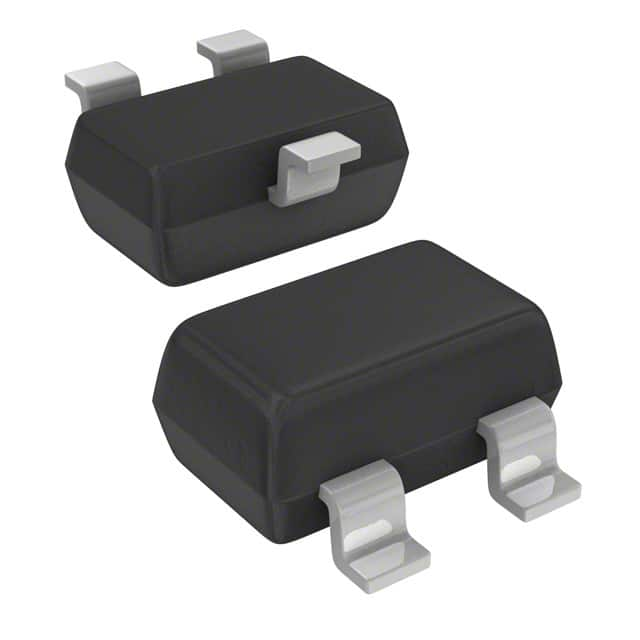HSMP-389C-TR1
Introduction
HSMP-389C-TR1 is a high-performance diode belonging to the category of surface mount PIN diodes. This entry provides an overview of its basic information, specifications, detailed pin configuration, functional features, advantages and disadvantages, working principles, detailed application field plans, and alternative models.
Basic Information Overview
- Category: Surface Mount PIN Diode
- Use: RF Switching, Attenuation, and Limiting
- Characteristics: High Isolation, Low Distortion, Fast Switching Speed
- Package: SOT-23
- Essence: High-Frequency Signal Control
- Packaging/Quantity: Tape and Reel, 3000 units per reel
Specifications
- Reverse Voltage: 100V
- Forward Current: 100mA
- Capacitance: 0.2pF at 0V, 1MHz
- Resistance: 2 Ohms at 10mA, 0.5V
- Power Dissipation: 225mW
Detailed Pin Configuration
The HSMP-389C-TR1 has three pins: 1. Anode 2. Cathode 3. No Connection (NC)
Functional Features
- High Isolation: Enables effective signal control and management.
- Low Distortion: Maintains signal integrity during switching and attenuation.
- Fast Switching Speed: Facilitates rapid response in RF applications.
Advantages and Disadvantages
Advantages
- High Isolation for improved signal control
- Low distortion ensures signal integrity
- Fast switching speed for rapid response
Disadvantages
- Limited reverse voltage compared to some alternatives
- Relatively low forward current capacity
Working Principles
The HSMP-389C-TR1 operates based on the principle of PIN diode behavior, utilizing its intrinsic properties to control RF signals through forward and reverse biasing.
Detailed Application Field Plans
The HSMP-389C-TR1 finds application in various fields such as: - RF Switching Circuits - RF Attenuators - RF Limiters - High-Frequency Signal Control Systems
Detailed and Complete Alternative Models
Some alternative models to HSMP-389C-TR1 include: - HSMP-381x Series - HSMS-28xx Series - HSMP-48xx Series
In conclusion, the HSMP-389C-TR1 is a surface mount PIN diode with high isolation, low distortion, and fast switching speed, making it suitable for RF switching, attenuation, and limiting applications.
[Word Count: 324]
Wymień 10 typowych pytań i odpowiedzi związanych z zastosowaniem HSMP-389C-TR1 w rozwiązaniach technicznych
What is HSMP-389C-TR1?
- HSMP-389C-TR1 is a high-speed silicon PIN diode commonly used in RF and microwave applications.
What are the key features of HSMP-389C-TR1?
- The key features include low capacitance, low series resistance, and high reverse voltage capability, making it suitable for high-frequency applications.
What are the typical applications of HSMP-389C-TR1?
- Typical applications include RF switches, attenuators, phase shifters, and mixers in wireless communication systems and radar.
What is the operating frequency range of HSMP-389C-TR1?
- The operating frequency range is typically from DC to several gigahertz, making it suitable for various high-frequency applications.
What is the maximum power handling capability of HSMP-389C-TR1?
- The maximum power handling capability is dependent on the specific application and operating conditions, but it is generally designed for low-power signal control.
What are the packaging options available for HSMP-389C-TR1?
- HSMP-389C-TR1 is available in various surface-mount packages such as SOT-23 and SOT-323, offering flexibility in design and assembly.
What are the thermal characteristics of HSMP-389C-TR1?
- The thermal characteristics include low thermal resistance and efficient heat dissipation, which are important for maintaining device reliability in high-frequency applications.
How does HSMP-389C-TR1 compare to other similar diodes in terms of performance?
- HSMP-389C-TR1 offers competitive performance in terms of low capacitance, low series resistance, and high linearity compared to other diodes in its class.
What are the recommended biasing and matching techniques for HSMP-389C-TR1?
- Proper biasing and matching techniques are crucial for optimizing the performance of HSMP-389C-TR1 in specific circuit configurations, and they should be carefully considered during design.
Where can I find detailed application notes and reference designs for using HSMP-389C-TR1 in technical solutions?
- Detailed application notes and reference designs can be found in the product datasheet, application guides from the manufacturer, and relevant technical literature on RF and microwave circuit design.


